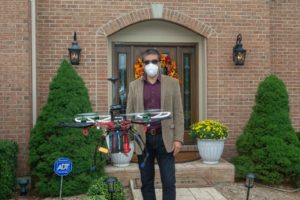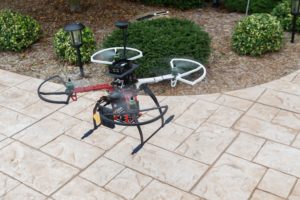“Inventors Victoria Wangia-Anderson, Manish Kumar, Seung-Yeon Lee and Debi Sampsel from three colleges at UC collaborated to develop a semi-autonomous prototype that can be dispatched right to people’s homes,” says a UC press release. “The drones are big enough to carry medicine or medical supplies but small enough to maneuver the tight confines of a home using navigational algorithms developed by UC engineers.”

Access to healthcare is a major problem around the world – one that has been exacerbated during the recent pandemic. In the U.S., 1 in 4 people do not have a primary care physician where they can receive regular care. Telehealth technologies have improved: and more and more healthcare providers are offering virtual office visits through technologies like Skype and Facetime. This kind of telehealth is a useful first step: but they require that patients have access to high speed internet. Receiving test kits, supplies, medications and other services still requires a patient to leave their home. The UC telehealth drone provides the camera and display screen so that patients can engage in a conversation with their provider. It also performs a delivery function, carrying a small waterproof box to deliver medical supplies, or collect lab tests.

Researchers from three colleges at UC collaborated on the new prototype. Professor Manish Kumar is a professor of mechanical engineering anddirector of the CDS Lab and co-director of the UAV MASTER Lab in the UC College of Engineering and Applied Science. Kumar’s lab is working on developing autonomous detect and avoid technologies that will help drones navigate cluttered 3D environments – which could mean dense forest, urban environments, or a patient’s living room.
While Kumar and his students were working on autonomous drone navigation systems, researchers at UC’s College of Nursing were working on improving telehealth capabilities, including telehealth robots. Dr. Debi Sampsel, director of telehealth at UC’s College of Nursing, and Kumar began to collaborate 7 years ago, realizing that telehealth drones could solve problems of telehealth regardless of where patients live.

Sampsel and UC professor Tamilyn Bakas were exploring new technology with telehealth robots for participants living independently. Sampsel said the logistics and communications needed to perform these tasks remotely got her thinking about ways telehealth delivery could be improved to reduce health care disparities regardless of where people live.
Drones can materially assist in getting telehealth services to a wide variety of areas. Drones navigate using satellite or cellular communications: and the telehealth drone comes equipped with its own interface for communicating with healthcare professionals.
Telehealth is a new area that could benefit from advances in drone technology that facilitate flight beyond visual line of sight (BVLOS) and drone delivery. Mobile, contactless tools that provide two-way communications and delivery functions have vast potential in healthcare – especially in a pandemic. With new regulations like flight over people and moving vehicles, scaling drone delivery to a wide variety of residential areas has become more feasible.
Wangia-Anderson, a professor of health informatics in UC’s College of Allied Health Sciences, said she is very interested in mitigating health disparities. Telehealth drones have useful public health applications such as delivering essential materials like medication or test kits or surveying public health conditions in neighborhoods to identify effective interventions. They also can be used to assess living conditions or to provide a substitute for in-person care during a pandemic or epidemic outbreak. The data they provide can be useful for interventions, clinical care, population health and other decision-making, she said.
Miriam McNabb is the Editor-in-Chief of DRONELIFE and CEO of JobForDrones, a professional drone services marketplace, and a fascinated observer of the emerging drone industry and the regulatory environment for drones. Miriam has penned over 3,000 articles focused on the commercial drone space and is an international speaker and recognized figure in the industry. Miriam has a degree from the University of Chicago and over 20 years of experience in high tech sales and marketing for new technologies.
For drone industry consulting or writing, Email Miriam.
TWITTER:@spaldingbarker
Subscribe to DroneLife here.
